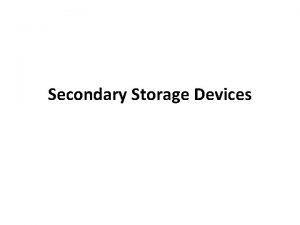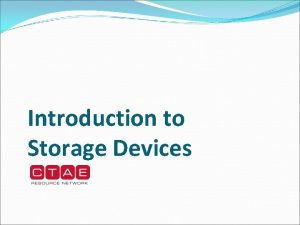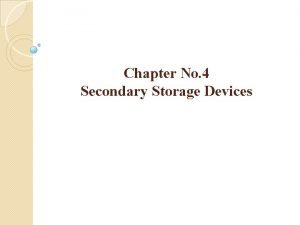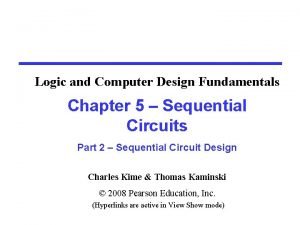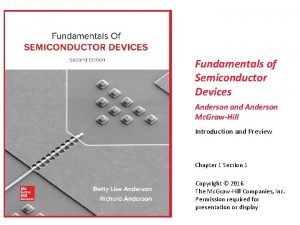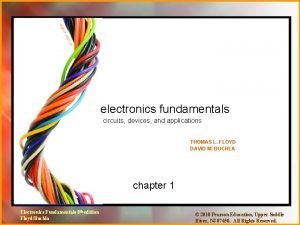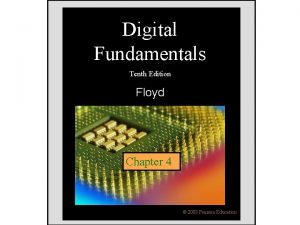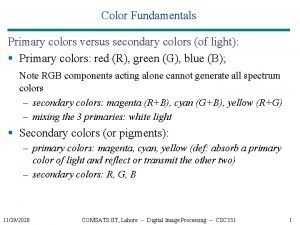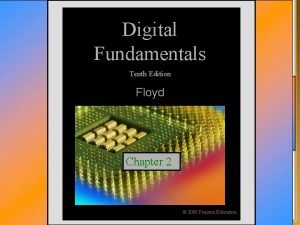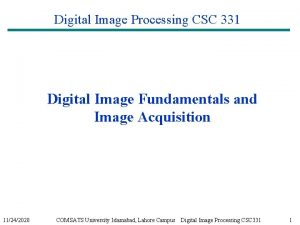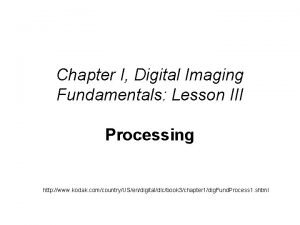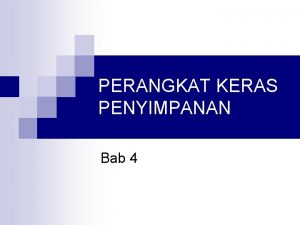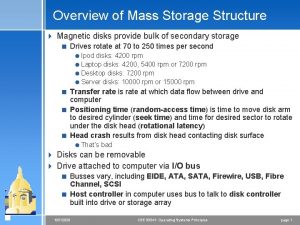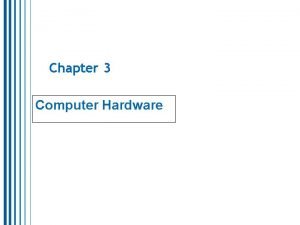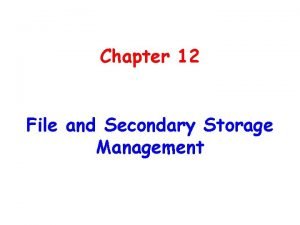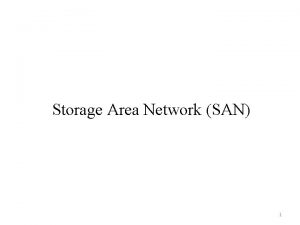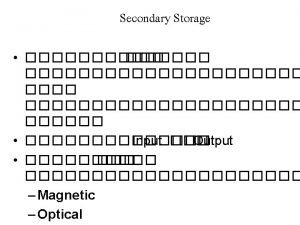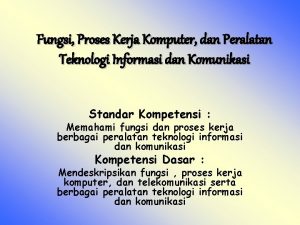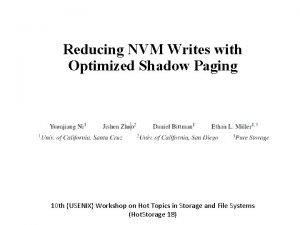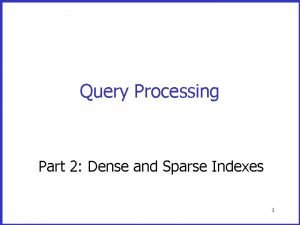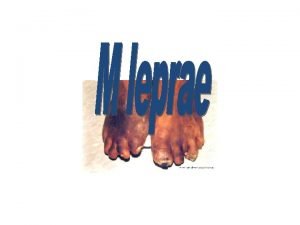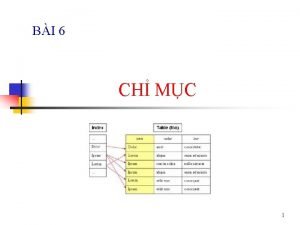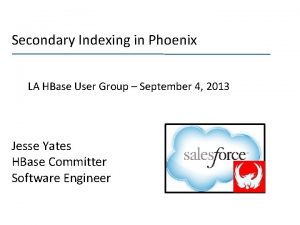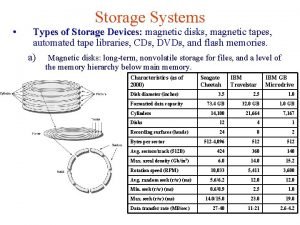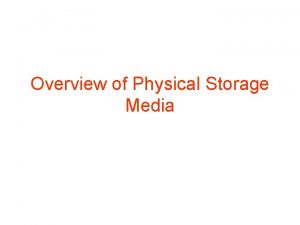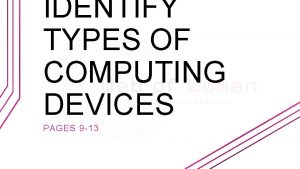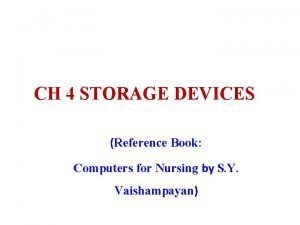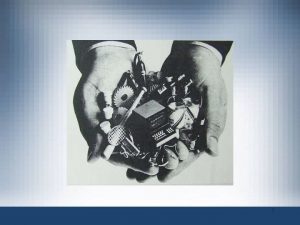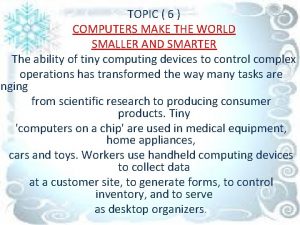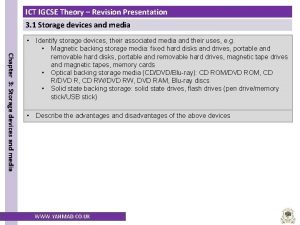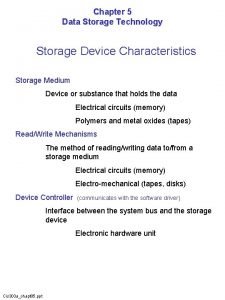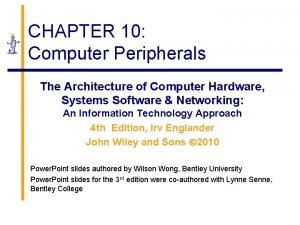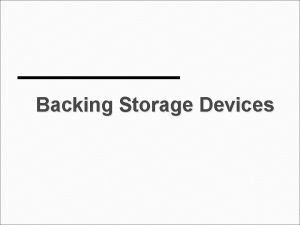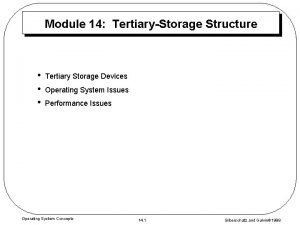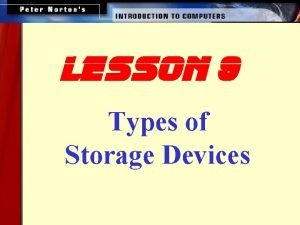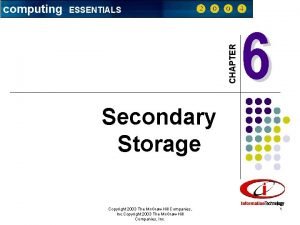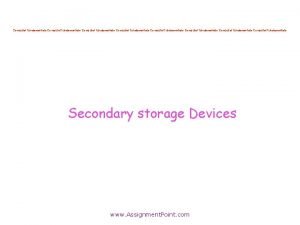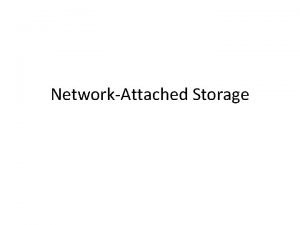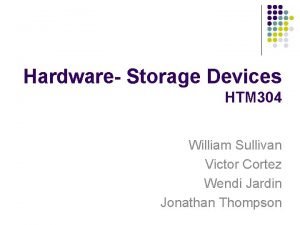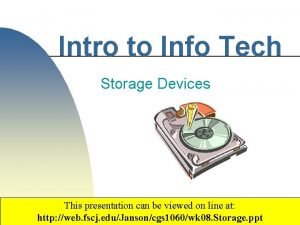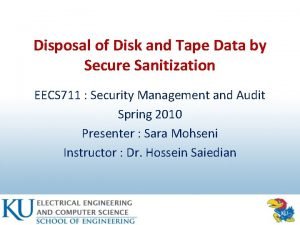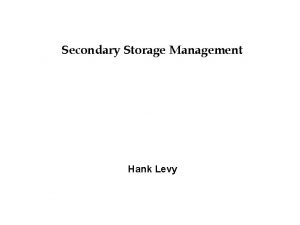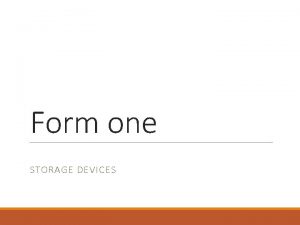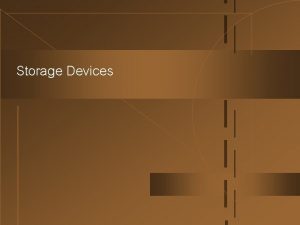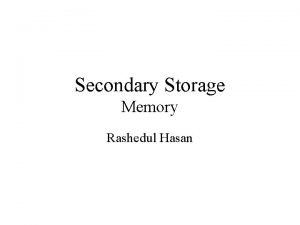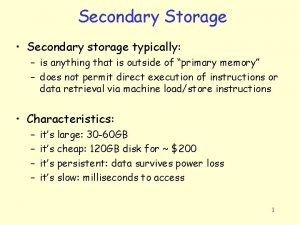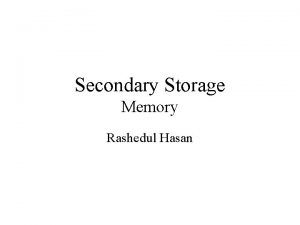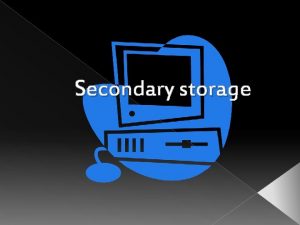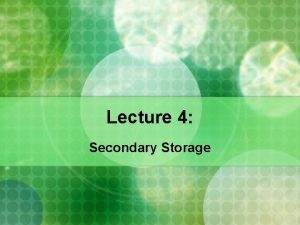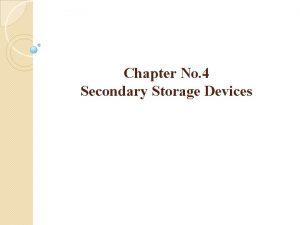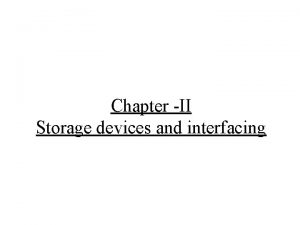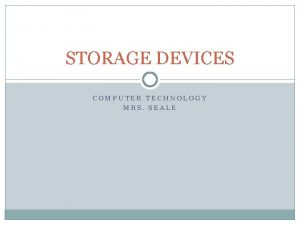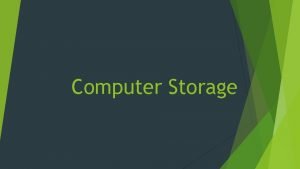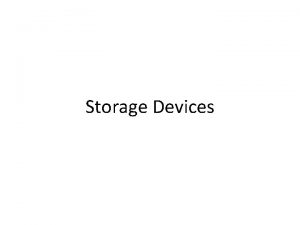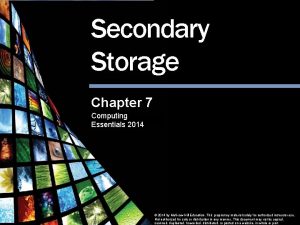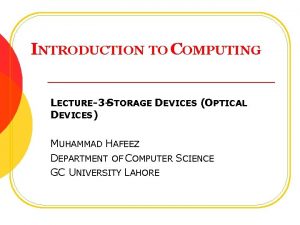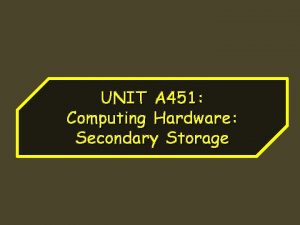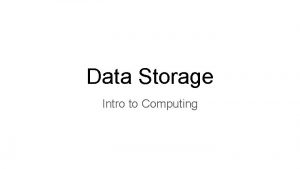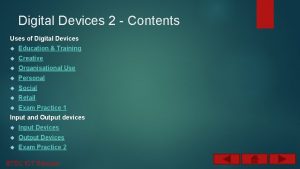FUNDAMENTALS OF DIGITAL COMPUTING SECONDARY STORAGE DEVICES INDEX
























































- Slides: 56

FUNDAMENTALS OF DIGITAL COMPUTING SECONDARY STORAGE DEVICES

INDEX • Secondary storage devices and their need • Classification of commonly used secondary storage devices • Difference between sequential and direct access storage devices • Basic principles of operation, types, and uses of popular secondary storage devices such as magnetic disk and optical disk • Commonly used mass storage devices • Storage Hierarchy, etc.

Limitations of Primary Storage • Limited capacity because the cost per bit of storageis high • Volatile - data stored in it is lost when the electric power is turned off or interrupted

Secondary Storage • Used in a computer system to overcome the limitations • of primary storage • Has virtually unlimited capacity because the cost per bit of storage is very low • Has an operating speed far slower than that of the primary storage • Used to store large volumes of data on a permanent basis • Also known as auxiliary memory

Classification of Commonly Used Secondary Storage Devices

Sequential-access Storage Devices • Arrival at the desired storage location may be preceded by sequencing through other locations • Data can only be retrieved in the same sequence in which it is stored • Access time varies according to the storage location of the information being accessed • Suitable for sequential processing applications where most, if not all, of the data records need to be processed one after another • Magnetic tape is a typical example of such a storage device

Direct-access Storage Devices • Devices where any storage location may be selected and accessed at random • Permits access to individual information in a more direct or immediate manner • Approximately equal access time is required for accessing information from any storage location • Suitable for direct processing applications such as online ticket booking systems, on-line banking systems • Magnetic, optical, and magneto-optical disks are typical examples of such a storage device

Magnetic Disk

Basics • Commonly used direct-access secondary storage device. • Physically, a magnetic disk is a thin, circular plate/platter made of metal or plastic that is usually coated on both sides with a magnetizable recording material such as iron-oxide • Data are recorded on the disk in the form of tiny invisible magnetized and non-magnetized spots (representing 1 s and 0 s) on the coated surfaces of the disk • The disk is stored in a specially designed protective envelope or cartridge, or several of them are stacked together in a sealed, contamination-free container

Storage Organization Illustrates the Concept of Tracks • A disk’s surface is divided into a number of invisible concentric circles called tracks • The tracks are numbered consecutively from outermost to innermost starting from zero • The number of tracks on a disk may be as few as 40 on small, lowcapacity disks, to several thousand on large, high-capacity disks

Illustrates the Concept of Sectors

Storage Organization

Disk Address or Address of a Record on a Disk • Disk address represents the physical location of the record on the disk • It is comprised of the sector number, track number, and surface number (when double-sided disks are used) • This scheme is called the CHS addressing or Cylinder. Head-Sector addressing. The same is also referred to as disk geometry

Magnetic Disk – Storage Organization (Illustrates the Concept of Cylinder)

Magnetic Disk – Storage Capacity • Storage capacity of a disk system = Number of recording surfaces x Number of tracks per surface x Number of sectors per track x Number of bytes per sector

Magnetic Disk Pack –Access Mechanism

Magnetic Disk – Access Time • Disk access time is the interval between the instant a computer makes a request for transfer of data from a disk system to the primary storage and the instant this operation is completed • Disk access time depends on the following three parameters: – Seek Time: It is the time required to position the read/write head over the desired track, as soon as a read/write command is received by the disk unit – Latency: It is the time required to spin the desired sector under the read/write head, once the read/write head is positioned on the desired track

– Transfer Rate: It is the rate at which data are read/written to the disk, once the read/write head is positioned over the desired sector • As the transfer rate is negligible as compared to seek time and latency, • Average access time = Average seek time + Average latency

Disk Formatting • Process of preparing a new disk by the computer system in which the disk is to be used. • For this, a new (unformatted) disk is inserted in the disk drive of the computer system and the disk formatting command is initiated • Low-level disk formatting – Disk drive’s read/write head lays down a magnetic pattern on the disk’s surface – Enables the disk drive to organize and store the data in the data organization defined for the disk drive of the computer

• OS-level disk formatting – Creates the File Allocation Table (FAT) that is a table with the sector and track locations of data – Leaves sufficient space for FAT to grow – Scans and marks bad sectors • One of the basic tasks handled by the computer’s operating system • Enables the use of disks manufactured by third party vendors into one’s own computer system

Magnetic Disk – Disk Drive • Unit used for reading/writing of data on/from a magnetic disk • Contains all the mechanical, electrical and electronic components for holding one or more disks and for reading or writing of information on to it

• Although disk drives vary greatly in their shape, size and disk formatting pattern, they can be broadly classified into two types: • Those with interchangeable magnetic disks, which allow the loading and unloading of magnetic disks as and when they are needed for reading/writing of data on to them • Those with fixed magnetic disks, which come along with a set of permanently fixed disks. The disks are not removable from their disk drives

Magnetic Disk – Disk Controller • Disk drive is connected to and controlled by a disk controller, which interprets the commands for operating the disk drive • Typically supports only read and write commands, which need disk address (surface number, cylinder/track number, and sector number) as parameters • Connected to and controls more than one disk drive, in which case the disk drive number is also needed as a parameters of read and write commands

Types of Magnetic Disks

Floppy Disks • Round, flat piece of flexible plastic disks coated with magnetic oxide • So called because they are made of flexible plastic plates which can bend • Also known as floppies or diskettes • Plastic disk is encased in a square plastic or vinyl jacket cover that gives handling protection to the disk surface

• The two types of floppy disks in use today are: – 5¼-inch diskette, whose diameter is 5¼-inch. It is encased in a square, flexible vinyl jacket – 3½-inch diskette, whose diameter is 3½-inch. It is encased in a square, hard plastic jacket • Most popular and inexpensive secondary storage medium used in small computers

A 3½ - inch Floppy Disk

Hard Disks • Round, flat piece of rigid metal (frequently aluminium) disks coated with magnetic oxide • Come in many sizes, ranging from 1 to 14 -inch • diameter. • Depending on how they are packaged, hard disks are of three types: • Zip/Bernoulli disks • Disk packs • Winchester disks • Primary on-line secondary storage device for most computer systems today

Zip/ Bernoulli Disks Uses a single hard disk platter encased in a plastic cartridge Disk drives may be portable or fixed type Fixed type is part of the computer system, permanently connected to it Portable type can be carried to a computer system, connected to it for the duration of use, and then can be disconnected and taken away when the work is done • Zip disks can be easily inserted/removed from a zip drive just as we insert/remove floppy disks in a floppy disk drive • • •

Disk Packs • Uses multiple (two or more) hard disk platters mounted on a single central shaft • Disk drives have a separate read/write head for each usable disk surface (the upper surface of the top-most disk and the lower surface of the bottom most disk is not used) • Disks are of removable/interchangeable type in the sense that they have to be mounted on the disk drive before they can be used, and can be removed and kept off-line when not in use

Winchester Disks • Uses multiple (two or more) hard disk platters mounted on a single central shaft • Hard disk platters and the disk drive are sealed together in a contamination-free container and cannot be separated from each other

• For the same number of disks, Winchester disks have larger storage capacity than disk packs because: – All the surfaces of all disks are used for data recording They employ much greater precision of data recording, resulting in greater data recording density • Named after the 30 -30 Winchester rifle because the early Winchester disk systems had two 30 -MB disks sealed together with the disk drive

Advantages of Magnetic Disks • More suitable than magnetic tapes for a wider range of applications because they support direct access of data • Random access property enables them to be used simultaneously by multiple users as a shared device. A tape is not suitable for such type of usage due to its sequentialaccess property • Suitable for both on-line and off-line storage of data • Except for the fixed type Winchester disks, the storage capacity of other magnetic disks is virtually unlimited as many disks can be used for storing very large data sets • Due to their low cost and high data recording densities, the cost per bit of storage is low for magnetic disks.

• An additional cost benefit is that magnetic disks can be erased and reused many times • Floppy disks and zip disks are compact and light in weight. Hence they are easy to handle and store. • Very large amount of data can be stored in a small storage space • Due to their compact size and light weight, floppy disks and zip disks are also easily portable from one place to another • They are often used for transferring data and programs from one computer to another, which are not linked together

• Any information desired from a disk storage can be accessed in a few milliseconds because it is a direct access storage device • Data transfer rate for a magnetic disk system is normally higher than a tape system • Magnetic disks are less vulnerable to data corruption due to careless handling or unfavorable temperature and humidity conditions than magnetic tapes

Limitations of Magnetic Disks • Although used for both random processing and sequential processing of data, for applications of thelatter type, it may be less efficient than magnetic tapes • More difficult to maintain the security of information stored on shared, on-line secondary storage devices, as compared to magnetic tapes or other types of magnetic disks • For Winchester disks, a disk crash or drive failure often • results in loss of entire stored data. It is not easy to recover the lost data. Suitable backup procedures are suggested for data stored on Winchester disks

• Some types of magnetic disks, such as disk packs and Winchester disks, are not so easily portable like magnetic tapes • On a cost-per-bit basis, the cost of magnetic disks is low, but the cost of magnetic tapes is even lower • Must be stored in a dust-free environment • Floppy disks, zip disks and disk packs should be labeled properly to prevent erasure of useful data by mistake

Uses of Magnetic Disks • For applications that are based on random data processing • As a shared on-line secondary storage device. Winchester disks and disk packs are often used for this purpose • As a backup device for off-line storage of data. Floppy disks, zip disks, and disk packs are often used for this purpose • Archiving of data not used frequently, but may be used once in a while. Floppy disks, zip disks, and disk packs are often used for this purpose

• Transferring of data and programs from one computer to another that are not linked together. Floppy disks and zip disks are often used for this purpose • Distribution of software by vendors. Originally sold software or software updates are often distributed by vendors on floppy disks and zip disks

Optical Disk – Basics • Consists of a circular disk, which is coated with a thin metal or some other material that is highly reflective • Laser beam technology is used for recording/reading of data on the disk • Also known as laser disk / optical laser disk, due to the use of laser beam technology • Proved to be a promising random access medium for high capacity secondary storage because it can store extremely large amounts of data in a limited space

Optical Disk – Storage Organization • Has one long spiral track, which starts at the outer edge and spirals inward to the center • Track is divided into equal size sectors Difference in track patterns on optical and magnetic disks.

Optical Disk – Storage Capacity Storage capacity of an optical disk = Number of sectors × Number of bytes per sector • The most popular optical disk uses a disk of 5. 25 inch diameter with storage capacity of around 650 Megabytes

Optical Disk – Access Mechanism

Optical Disk – Access Time • With optical disks, each sector has the same length regardless of whether it is located near or away from the disk’s center • Rotation speed of the disk must vary inversely with the radius. Hence, optical disk drives use a constant linear velocity (CLV) encoding scheme • Leads to slower data access time (larger access time) for optical disks than magnetic disks • Access times for optical disks are typically in the range of 100 to 300 milliseconds and that of hard disks are in the range of 10 to 30 milliseconds

Optical Disk Drive

• Uses laser beam technology for reading/writing of data • Has no mechanical read/write access arm • Uses a constant linear velocity (CLV) encoding scheme, in which the rotational speed of the disk varies inversely with the radius

Types of Optical Disks • The types of optical disks in use today are: CD-ROM • Stands for Compact Disk-Read Only Memory • Packaged as shiny, silver color metal disk of 5¼ inch (12 cm) diameter, having a storage capacity of about 650 Megabytes • Disks come pre-recorded and the information stored on them cannot be altered • Pre-stamped (pre-recorded) by their suppliers, by a process called mastering

• Provide an excellent medium to distribute large amounts of data in electronic dorm at low cost. • A single CD-ROM disk can hold a complete encyclopedia, or a dictionary, or a world atlas, or biographies of great people, etc • Used for distribution of electronic version of conference proceedings, journals, magazines, books, and multimedia applications such as video games • Used by software vendors for distribution of software to their customers

WORM Disk / CD-Recordable ( CD-R) • Stands for Write Once Read Many. Data can be written only once on them, but can be read many times • Same as CD-ROM and has same storage capacity • Allow users to create their own CD-ROM disks by using a CDrecordable (CD-R) drive that can be attached to a computer as a regular peripheral device • Data to be recorded can be written on its surface in multiple recording sessions

• Sessions after the first one are always additive and cannot alter the etched/burned information of earlier sessions • Information recorded on them can be read by any ordinary CD -ROM drive • They are used for data archiving and for making a permanent record of data. For example, many banks use them for storing their daily transactions

CD-Read/ Wr ite ( CD-RW) • Same as CD-R and has same storage capacity • Allow users to create their own CD-ROM disks by using a CDrecordable (CD-R) drive that can be attached to a computer as a regular peripheral device • Data to be recorded can be written on its surface in multiple recording sessions • Made of metallic alloy layer whose chemical properties are changed during burn and erase • Can be erased and written afresh

Digital Video / Versatile Disk ( DVD) • Looks same as CD-ROM but has capacity of 4. 7 GB or 8. 5 GB • Designed primarily to store and distribute movies • Can be used for storage of large data • Allows storage of video in 4: 3 or 16: 9 aspect-ratios in MPEG-2 video format using NTSC or PAL resolution • Audio is usually Dolby® Digital (AC-3) or Digital Theater System (DTS) and can be either monaural or 5. 1 Surround Sound

Uses of Optical Disks • For distributing large amounts of data at low cost • For distribution of electronic version of conference proceedings, journals, magazines, books, product catalogs, etc • For distribution of new or upgraded versions of software products by software vendors • For storage and distribution of a wide variety of multimedia applications • For archiving of data, which are not used frequently, but which may be used once in a while • WORM disks are often used by end-user companies to make permanent storage of their own proprietary information

Memory Storage Devices Flash Drive ( Pen Drive) • Relatively new secondary storage device based on flash memory, enabling easy transport of data from one computer to another • Compact device of the size of a pen, comes in various shapes and stylish designs and may have different added features • Plug-and-play device that simply plugs into a USB (Universal Serial Bus) port of a computer, treated as removable drive • Available storage capacities are 8 MB, 16 MB, 64 MB, 128 MB, 256 MB, 512 MB, 1 GB, 2 GB, 4 GB, and 8 GB

Memory Card ( SD/ MMC) • Similar to Flash Drive but in card shape • Plug-and-play device that simply plugs into a port of a computer, treated as removable drive Useful in electronic devices like Camera, music player • Available storage capacities are 8 MB, 16 MB, 64 MB, 128 MB, 256 MB, 512 MB, 1 GB, 2 GB, 4 GB, and 8 GB

Storage Hierarchy • As a single type of storage is not superior in speed of access, capacity, and cost, most computer systems make use of a hierarchy of storage technologies as shown below.
 Primary storage vs secondary storage
Primary storage vs secondary storage Primary storage and secondary storage
Primary storage and secondary storage Secondary storage provides temporary or volatile storage
Secondary storage provides temporary or volatile storage Benefits of secondary storage
Benefits of secondary storage Magnetic tape secondary storage device
Magnetic tape secondary storage device Introduction to storage
Introduction to storage Magnetic
Magnetic Fundamentals of logical computing formulation
Fundamentals of logical computing formulation Object based and unified storage
Object based and unified storage Conventional computing and intelligent computing
Conventional computing and intelligent computing Fundamentals of semiconductor devices
Fundamentals of semiconductor devices Electronics fundamentals circuits devices and applications
Electronics fundamentals circuits devices and applications Hops storage index
Hops storage index Digital fundamentals chapter 4
Digital fundamentals chapter 4 Digital fundamentals floyd ppt
Digital fundamentals floyd ppt Digital fundamentals 10th edition
Digital fundamentals 10th edition Color fundamentals in digital image processing
Color fundamentals in digital image processing Digital fundamentals floyd 10th edition
Digital fundamentals floyd 10th edition Digital fundamentals answers
Digital fundamentals answers Image processing
Image processing Fundamentals of digital imaging
Fundamentals of digital imaging Contoh secondary storage
Contoh secondary storage Secondary storage structure
Secondary storage structure Computer hardware history
Computer hardware history Secondary storage management
Secondary storage management Nas fiber channel
Nas fiber channel Magnetic disk
Magnetic disk Diagram umum dari komputer
Diagram umum dari komputer Shadow paging
Shadow paging Diff between step index and graded index fiber
Diff between step index and graded index fiber Primary index is dense or sparse
Primary index is dense or sparse Eryhtema nodosum
Eryhtema nodosum Compare india and sri lanka on the basis of hdi
Compare india and sri lanka on the basis of hdi Single mode fiber supports meridional rays
Single mode fiber supports meridional rays Simpsons index
Simpsons index Atterberg limits
Atterberg limits Clustered index và non clustered index
Clustered index và non clustered index Phoenix
Phoenix Types of i/o devices
Types of i/o devices Overview of physical storage media in dbms
Overview of physical storage media in dbms Types of computing devices
Types of computing devices Input device output device storage device
Input device output device storage device The access method used for magnetic tape is
The access method used for magnetic tape is Types of storage devices
Types of storage devices Computers make the world smaller and smarter answers
Computers make the world smaller and smarter answers Igcse ict chapter 3
Igcse ict chapter 3 Characteristics of storage devices
Characteristics of storage devices Computer peripherals storage devices
Computer peripherals storage devices Backing storage device
Backing storage device Tertiary storage
Tertiary storage Types of optical storage
Types of optical storage Mass storage devices are specialized high capacity
Mass storage devices are specialized high capacity Magnetic disk uses
Magnetic disk uses Storage devices
Storage devices 3 storage devices
3 storage devices Storage devices presentation
Storage devices presentation Data tape disposal
Data tape disposal




